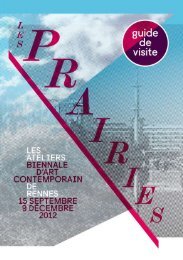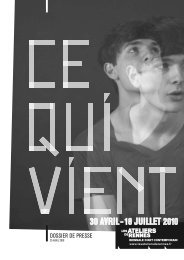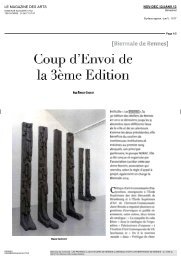Download here the Visitor's guide. - Les Ateliers de Rennes
Download here the Visitor's guide. - Les Ateliers de Rennes
Download here the Visitor's guide. - Les Ateliers de Rennes
You also want an ePaper? Increase the reach of your titles
YUMPU automatically turns print PDFs into web optimized ePapers that Google loves.
50<br />
<strong>Les</strong> Prairies's artists<br />
ANDRé GUEDES<br />
Nova Árgea, 2012. Photography : Vera Keel.<br />
André Gue<strong>de</strong>s's plastic work is based on extensive documentary research and un<strong>de</strong>rpinned<br />
by an anthropological reflection on <strong>the</strong> influence of human activity in <strong>the</strong> <strong>de</strong>sign of spaces. On<br />
being invited to <strong>the</strong> PHAKT Centre Culturel Colombier as part of <strong>the</strong> 2012 <strong>Ateliers</strong> <strong>de</strong> <strong>Rennes</strong>,<br />
Gue<strong>de</strong>s created a project that is an oblique response to <strong>the</strong> architecture and <strong>the</strong> social aspects<br />
of <strong>the</strong> Colombier area. His installation Nova Árgea inclu<strong>de</strong>s a sli<strong>de</strong>show of staged photographs<br />
<strong>de</strong>picting members of a present-day, fictional community in a real-life situation. It creates a<br />
visual and text-based narrative in which poet Fiama Hasse Pais Brandão, urbanist Gaston<br />
Bar<strong>de</strong>t and artist Clara Batalha all take part. The narrative was inspired by <strong>the</strong> story of an<br />
agricultural co-operative called A Comunal in Árgea, a Portuguese village. This was during<br />
<strong>the</strong> period known as PREC (Processo Revolucionário Em Curso, or 'On-Going Revolutionary<br />
Process') after Portugal's Carnation Revolution of April 1974. The foun<strong>de</strong>rs of this co-op were<br />
urban intellectuals who hoped to get closer to <strong>the</strong> rural population and to fire <strong>the</strong>m with<br />
"cultural dynamism". To attain <strong>the</strong>ir revolutionary i<strong>de</strong>al of fraternity between <strong>the</strong> social classes,<br />
<strong>the</strong>y attempted to set up an agricultural project with <strong>the</strong> peasants and <strong>the</strong> rural proletariat,<br />
based on exchange of knowledge and a fair contribution from everyone involved. This i<strong>de</strong>alist<br />
experiment, updated and re-interpreted in Nova Árgea, was contemporary with <strong>the</strong> creation of<br />
<strong>the</strong> Colombier area. However, although Colombier may have embodied aspirations of mo<strong>de</strong>rn<br />
comfort, it was perhaps less concerned with social and cultural emancipation than Árgea. The<br />
architect's vision reflected an economic mo<strong>de</strong>l less imbued with i<strong>de</strong>alism.<br />
tr. J.H.<br />
Born in 1971 in Lisbon (Portugal), w<strong>here</strong> he lives and works.<br />
Co-Production<br />
<strong>Les</strong> <strong>Ateliers</strong> <strong>de</strong> <strong>Rennes</strong> 2012,<br />
PHAKT Centre Culturel Colombier.<br />
retrouvez cet artiste au PHAKT, Centre Culturel Colombier






